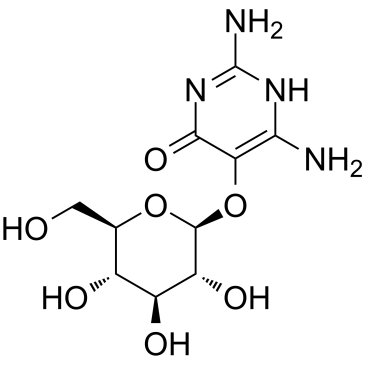Vicine

Vicine structure
|
Common Name | Vicine | ||
|---|---|---|---|---|
| CAS Number | 152-93-2 | Molecular Weight | 304.257 | |
| Density | 2.2±0.1 g/cm3 | Boiling Point | 627.4±65.0 °C at 760 mmHg | |
| Molecular Formula | C10H16N4O7 | Melting Point | 242-244℃ | |
| MSDS | USA | Flash Point | 333.2±34.3 °C | |
|
Effect of air classification and fermentation by Lactobacillus plantarum VTT E-133328 on faba bean (Vicia faba L.) flour nutritional properties.
Int. J. Food Microbiol. 193 , 34-42, (2015) The effects of air classification and lactic acid bacteria fermentation on the reduction of anti-nutritional factors (vicine and convicine, trypsin inhibitor activity, condensed tannins and phytic acid) and in vitro protein and starch digestibility of faba be... |
|
|
Vicianin, prunasin, and beta-cyanoalanine in common vetch seed as sources of urinary thiocyanate in the rat.
J. Agric. Food Chem. 49(10) , 5075-80, (2001) When young rats were fed a diet containing common vetch seed for 1 month, they excreted in the urine approximately 7 times more thiocyanate than they had ingested. Vicianin, prunasin, and beta-cyanoalanine were identified as principal dietary sources of the e... |
|
|
Biocatalytic production of alpha-hydroxy ketones and vicinal diols by yeast and human aldo-keto reductases.
Chem. Biol. Interact. 202(1-3) , 195-203, (2013) The α-hydroxy ketones are used as building blocks for compounds of pharmaceutical interest (such as antidepressants, HIV-protease inhibitors and antitumorals). They can be obtained by the action of enzymes or whole cells on selected substrates, such as diketo... |
|
|
New evidence for the mechanism of the tin(II) chloride catalyzed reactions of vicinal diols with diazodiphenylmethane in 1,2-dimethoxyethane.
Carbohydr. Res. 331(3) , 239-45, (2001) A kinetic study of the tin(II) chloride catalyzed reaction of diazodiphenylmethane with ethylene glycol in dimethoxyethane is reported. The preparation and characterization of ethylene glycol monodiphenylmethyl ether, the main product from this reaction, is a... |
|
|
Vicine and convicine in common vetch (Vicia sativa) seeds enhance beta-cyanoalanine toxicity in male broiler chicks.
Int. J. Toxicol. 21(3) , 201-9, (2002) Two studies were conducted to investigate the effects of feeding raw and water-soaked vetch seeds to male broiler chicks on performance, organ weights, and blood parameters. Intact and ground vetch seeds were soaked in water (1:5) at room temperature for 24 h... |
|
|
Osmium-catalyzed vicinal oxyamination of alkenes by N-(4-toluenesulfonyloxy)carbamates.
J. Org. Chem. 77(19) , 8480-91, (2012) N-(4-toluenesulfonyloxy)carbamates based on a range of common amine protecting groups serve as preformed nitrogen sources in the intermolecular osmium-catalyzed oxyamination reaction of a variety of mono-, di-, and trisubstituted alkenes. The reactions occur ... |
|
|
Release of iron from ferritin by divicine, isouramil, acid-hydrolyzed vicine, and dialuric acid and initiation of lipid peroxidation.
Arch. Biochem. Biophys. 271(2) , 536-45, (1989) Release of iron from ferritin by the polyhydroxypyrimidines, dialuric acid, isouramil, divicine, and acid-hydrolyzed vicine, was measured. Iron was released at fast initial rates which gradually declined to zero in 10 min. All the compounds were better reduct... |
|
|
Hydrolysis of vicine and convicine from fababeans by microbial beta-glucosidase enzymes.
J. Appl. Bacteriol. 72(6) , 475-8, (1992) The toxic glycosides vicine and convicine which are present in fababeans have been implicated in favism, an anaemic disease of humans. Vicine and convicine concentrations are reduced by growth of Lactobacillus plantarum on fababean suspensions. The glycosides... |
|
|
Chemical analysis and hemolytic activity of the fava bean aglycon divicine.
Chem. Res. Toxicol. 6(4) , 439-44, (1993) Divicine is an unstable aglycon metabolite of the fava bean pyrimidine beta-glucoside vicine. Divicine has long been thought to be a mediator of an acute hemolytic crisis, known as favism, in susceptible individuals who ingest fava beans (Vicia faba). However... |
|
|
[The degradation of vicine and convicine in field bean meal by selected bacterial strains].
Nahrung 35(5) , 449-53, (1991) Vicine and convicine as natural occurring toxic compounds in Vicia faba are involved in the formation of hemolytic anemia (favism). Removal of these compounds needs high technological expense. Microbiological degradation with different strains of bacteria was... |